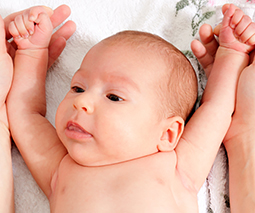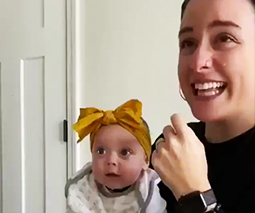A guide to baby’s teething: Timing, symptoms and pain relief

Teething is pretty painful for baby … and for you. Here are the signs to watch for, the basic teething timelines, and some soothing remedies that can help you both through it.
The teething timeline
So when exactly do your baby’s first teeth start to poke through? Lots of babies will get their first tooth around the 6-month mark. But some children might cut a tooth as early as three months, or much much later, around 12-14 months.
The first teeth to appear around six months are usually the two bottom front teeth (central incisors). These are quickly followed by the four upper teeth (central and lateral incisors). Since these are thin teeth, they tend to cut through quickly.
Then … it’s hello molars. Around your baby’s first birthday, the molars will start to rear their heads, and these can be quite painful for baby because they’re a big, broad-surfaced tooth. After the molars, around 18 months, come the pointed teeth known as canines, and then by the time your child’s two, the second set of rear molars start to bust a move.
Signs and symptoms
There are lots of theories about possible teething symptoms, but every baby’s different, so short of seeing a tooth peek through, it’s generally a waiting game. Here are some things you may (or may not) notice in the lead up to a tooth:
Lots of drooling
Infants drool, so this can be a misleading one. However some parents do report that their baby’s drooling increases noticeably before a tooth.
The munchies
Teething babies tend to like having a chomp on things to relieve the pressure of an emerging tooth underneath their gums. Watch to see if your bub’s chewing instinct has increased, and experiment with a safe teething product.
Fussiness
Even if you have a dream sleeper on your hands, you might notice your baby starts getting particularly fussy before a tooth comes through. This is especially true at night, when an impending tooth eruption may disrupt your baby’s sleep.
Change in appetite
It makes sense that sore gums would impact your child’s eating habits. Some babies feed less due to inflamed gums. Others might want more food – and different types, like cold yoghurts or fruit if they’re on solids.

Easing the pain
It’s not easy seeing your baby go through these patches of discomfort, and your old routine might get disrupted for a few days. Aside from the plethora of teething toys you can buy for your bub, here are a few things you can try to ease their pain:
A cold, wet facecloth
Lots of parents swear by this old-fashioned remedy. It’s cheap and easy, and the thick, wet fabric is effective at easing sore gums. You could chill the face cloth in the fridge, just be careful with freezing anything.
Pain relief
If your baby’s really upset by the pain, you could consider an appropriate dose of paracetamol or ibuprofen, or one of the over-the-counter oral anaesthetics for babies. Ensure you follow the recommended doses for your child’s age, and talk to your doctor if symptoms become worse.
Distraction
If all else fails, look for simple, comforting ways to distract from the pain. Often just helping your child get their mind off the pain can help. Maybe it’s a trip out of the house, a new toy, or a nice cuddle.
Caring for baby teeth
You can start cleaning your baby’s teeth as soon as they appear. Simply wipe teeth twice a day with a clean, damp face washer. Or, if your baby doesn’t mind, you could introduce a a soft toothbrush designed for babies under two. Once your child is eighteen months, you can start using a small amount of child-friendly toothpaste.
While there might be some tears, and a few sleepless nights that come with teething, it’ll all be worthwhile when you see that big toothy smile on your toddler!
This post was originally published on 20 July 2017









